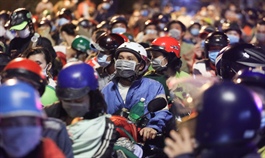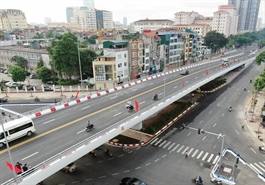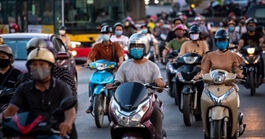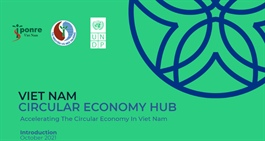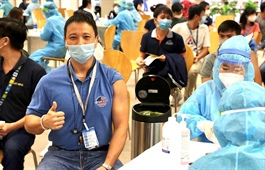HCMC hopeful vaccination will cure economic pain
HCMC hopeful vaccination will cure economic pain
In the last four months Covid-19 has turned life in HCMC upside down and dented its economy, but improving vaccination figures stir hopes of a recovery.
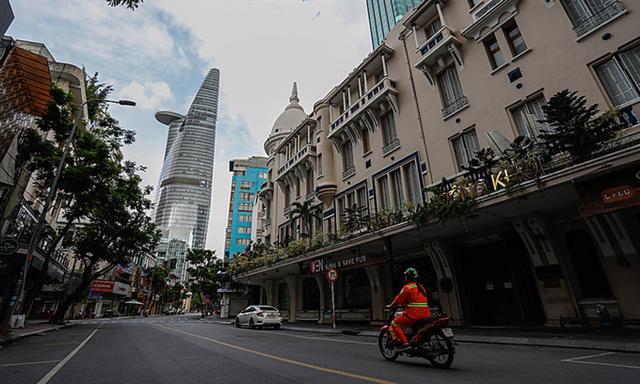
A motorbike driver is seen on a deserted road in Ho Chi Minh City on Sept. 7, 2021 during a social distancing period. Photo by VnExpress/Huu Khoa |
Tents, blankets, sheets, mats and buckets became sought-after items in June when companies started preparing to house their employees at the workplace after the city mandated stay-in-place restrictions to contain the pandemic.
"It was almost like a battle," the director of a manufacturing company said.
A fourth wave of Covid had broken out, and companies were required to either close or have employees stay on-site starting from July 15.
But by September only around 20 percent of production could be maintained, Chu Tien Dung, chairman of the HCMC Union of Business Association,said.
In the central business area of District 1, the financial streets of Ham Nghi and Nguyen Cong Tru, usually filled with stock brokers and bankers, were deserted, while nearby Bui Vien Street, a popular tourist hangout, was unusually quiet as bars and karaoke parlors were shut.
Traditional markets were closed and supermarkets restricted the number of customers at a time, which at times made vegetables and meat prized items.
With around 6,000 Covid-19 cases being found each day by early September, Vietnam’s biggest city had been brought to its knees, with an economic collapse even threatening stability.
When the locomotive derails
HCMC, dubbed the locomotive of the nation, started off the year on a bright note with its economy growing at 5.46 percent to VND680.34 trillion ($29.97 billion) in the first six months.
But things changed in the third quarter. In August trade fell 39 percent from June, while services and retail sales plummeted to 30 percent of pre-pandemic figures.
The situation did not improve in September, with the index of industrial production declining by 12.9 percent year-on-year.
Only 594 new businesses were registered in the entire month, lower than the average daily rate before the pandemic.
An estimated 381,400 people lost their jobs.
Ninety percent of companies said they were struggling more in the third quarter than in the second, according to a survey by the General Statistics Office.
Foreign direct investment in September was 27.7 percent down year-on-year.
"The negative economic growth, over half of the population in difficulty and over 80 percent of companies reporting challenges were all unprecedented in Ho Chi Minh City," Nguyen Trong Hoai, a lecturer at the University of Economics HCMC, said.
Caught by surprise
The fourth wave came just after Vietnam was hailed as one of the most successful countries in containing the pandemic.
"No one expected the fourth wave," Nguyen Thanh My, president of printer manufacturer Rynan Technologies, said, adding that businesses, authorities and the public were equally at sea in dealing with the outbreak.
Nguyen Anh Duc, CEO of retail chain Saigon Co.op, said though the cost of food items rose, supermarkets were not allowed to increase their prices.
Labor shortage due to lockdowns and social distancing also caused challenges and there were times when Duc’s staff had to work 18-20 hours a day and still could not provide enough goods to shoppers.
At times Saigon Co.op had to close 25 percent of its outlets due to labor shortagethough still meeting overhead expenses like rent.
For manufacturing companies, the stay-at-work model was financially disastrous since testing workers regularly cost billions of dong every month (VND1 billion = $44,014).
It was a time of stress also for employees.
With 295 workers living at the Binh Minh Plastic factory premises, the atmosphere of tension was overwhelming, CEO Nguyen Hoang Ngan said.
"News had a major impact on workers, and rumors and fake information dominated."
The situation was similar at dry fruit producer Vinamit.
Nguyen Lam Vien, its CEO, said: "There were meetings in June when we only discussed how to stop Covid-19 from spreading. It was terrible".
Disruptions in supply chains made the situation worse. The country’s biggest port, Cat Lai, stopped accepting oversized and overweight cargo at the end of July after a container pileup due to transport restrictions and closure of businesses that had to take delivery of them due to Covid.
But even after the port resumed normal operations in early August, companies faced trouble with goods delivery since they had to have their drivers tested every two or three days, delaying transport.

Shippers wait to be tested of Covid-19 before work in Go Vap District, Ho Chi Minh City on Sept. 20, 2021. Photo by VnExpress/Quynh Tran |
Only half the travel permit requests were approved as of the end of August, chairman of the HCMC Cargo Transport Association, Bui Van Quan, said.
Delivery within the city was also difficult due to the shortage of drivers and costs surged as a result.
Inconsistent implementation of regulations and arbitrary definition of "essential goods" by officials plunged the city’s 34 delivery companies into a state of uncertainty.
The impact on HCMC, the locomotive of the economic train, threatened to have a ripple effect on the entire southern region.
"Growth in the southern region could plunge, unemployment could rise, and the government’s revenues could be negatively impacted," a report by the University of Economics and Law said.
Breaking point
"The endurance of society has reached breaking point and the economy is hurt, which calls for initiating a recoveryprocess," HCMC general secretary Nguyen Van Nen said at a meeting on Sep. 17, one day after the city allowed three districts to gradually reopen.
In the event, the rest of the city was allowed to reopen two weeks later, ending four months of varying levels of social distancing.

Vehicles are seen in Ho Chi Minh City on Oct. 1, 2021 as the city begins to resume activities after months of social distancing. Photo by VnExpress/Quynh Tran |
But the threat has not gone away. With 3,000-4,000 new cases and around 100 deaths every day, the reopening must be accompanied by safety measures, Hoai of the University of Economics HCMC said.
If 80 percent of the city population is fully vaccinated by the end of this year or early next year, the city can reopen fully, but for now the main approach should be risk management since there are still infected people in the community, he said.
As of Oct. 3, the rate of people who had got both vaccine shots was 60.6 percent.
Other experts concurred.
Pham Thi Thanh Xuan, a lecturer at the University of Economics and Law, said the city needs to have a mechanism in place for businesses and people to go about normally while still limiting contagion.
"They should be empowered to live with Covid-19 and take responsibility to prevent transmission."
Businesses continue to face problems.
"Some electronic parts take 10 weeks to be delivered," My of Rynan Technologies said, referring to the disruptions in the supply chain.
Labor is set to be an issue as many workers have left the city for their hometowns while those who want to come back are unable to because they are not vaccinated.
Hoai said workers who want to return to the city should be prioritized for vaccination and travel.
"There will be risks but we should be optimistic" because the city has the highest vaccination rate in the country and within two weeks the number of new cases could drop noticeably, he added.



